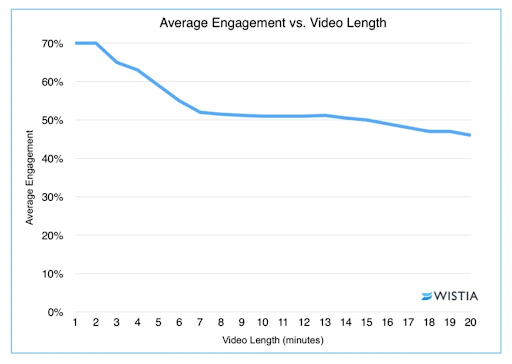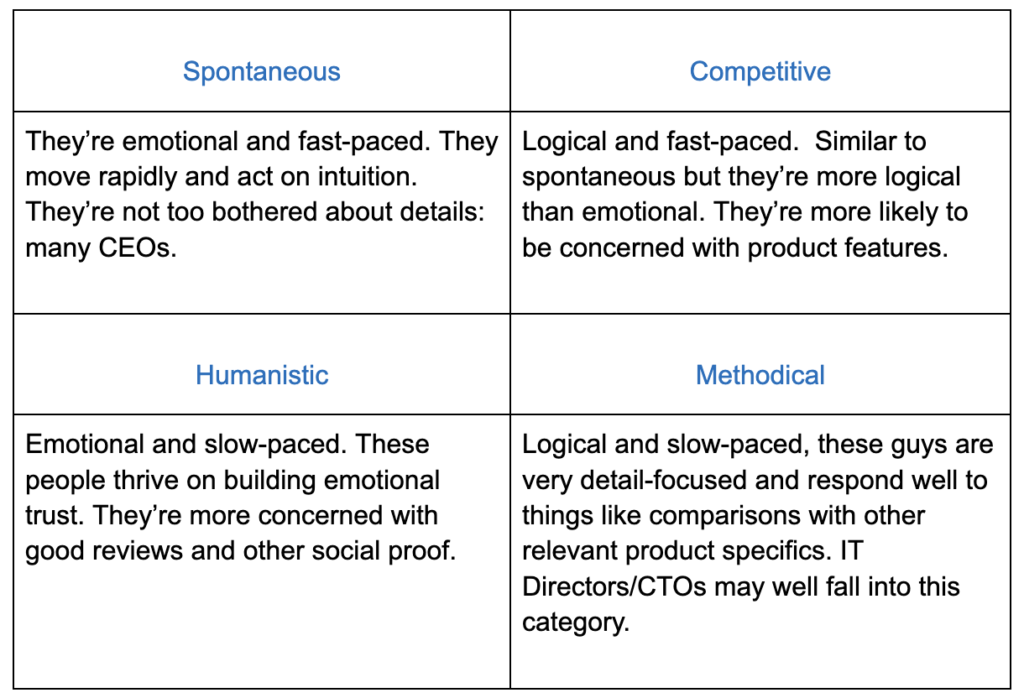Here’s Why Ideal Explainer Video Length Is a Myth (Sort Of)

We’ve all heard the news. “Human attention spans are now 8 seconds…”
(One year later)
“Human attention spans are 2.34 seconds…. Human brains are turning to mush” etc., etc. The stats from the business video creation/hosting platform Vidyard seem to back this up.
The majority of their videos (60%) are less than 2 minutes long
Only 24% will finish a video if it’s longer than 20 minutes
Only 3% of business videos are 10 to 20 minutes long
Basically, if you make a long video nobody’s gonna watch it
The stats from the b2b video hosting platform, Wistia say something similar on the topic of explainer video length.

Beyond 2 minutes, significantly more people stop watching. Understandable; one reason is that shorter videos simply have less time within which people can click away. Another reason is that people just don’t have the time or brainpower for watching anything lengthy… Or do they?
People’s attention spans are better than you think
If our brains were allergic to holding attention and shorter was better then the Joe Rogan Experience, the most successful podcast on earth wouldn’t be 2.5 hours long and Martin Scorsese might be unemployed. Even if we look at online video outside of a business context we see plenty of evidence that people don’t have goldfish brains. Many of us will happily devour a 15-minute TED talk. And the length of video that YouTube favors is around the ten-minute mark. What’s that I hear you say?”
“O.K but that’s entertainment, in a marketing context videos need to be shorter.”
I firmly disagree. Harmon Brothers videos, some of the most successful explainer videos of all time, frequently land in the 3-4 minute mark.
And then there are video sales letters. These can come in anywhere from 10 - 90 minutes (that’s not a typo) and are so effective that people who write them can charge up to six figures for a script. Here’s a “short” one I found on YouTube.
“O.K but those are freak examples,
I’m just trying to create a normal explainer video here.”
Maybe, but there are important lessons to be learned from those two examples. Firstly, all Harmon Brothers videos are pretty entertaining. And as a viewer, you’re happy to hear an otherwise boring marketing message for 2+ minutes if it’s presented engagingly.
Secondly, both Harmon Brothers videos and VSLs are built upon insights derived from piles and piles of customer and product research data. This means everything they say is striking a chord with their target audience and building the kind of trust and empathy that few marketing messages ever achieve. To illustrate the power of really knowing your customer, one of my old tutors in ad school told me the following.
“If I were to write a ten-thousand-word essay entirely about you,
then you would read all of it.”
And that’s the approach both Harmon Brothers videos and any good VSL employ. Yes, I will happily admit that if you want to create an explainer video that your audience will watch to the very end, then keeping things under two minutes is a safe bet. BUT, if what you’re saying is a) highly relevant to the prospect’s problems and b) entertaining, two minutes should by no means be the limit. You wouldn’t trim a TED talk down to 2 minutes, would you?
That said, there’s no reason to be verbose. Every element of a video needs to be like a Formula 1 car; nothing is there for the sake of it, everything is performing a highly necessary function. You’ve still got to hook your audience in the first few seconds. And you still shouldn’t cram everything about your product into the video. Just what needs to be said to advance your audience to the next stage of the sales process. Be that booking a call, signing up for a trial, browsing the rest of the website, etc.
In my opinion, there is no such thing as recommended length. Only videos that:
a) End before they get boring
b) Communicate the information that’s necessary for moving prospects to the next stage of the marketing funnel
c) Are appropriate to the goals, situation, and environment that the video is presented in
N.B. points b) and c) will help with point a)
Depending on what you need to say, how you need to say it, where you need to say it, and who you need to say it to, that will determine optimum explainer video length. So the question “how long should my explainer video be?” should be replaced by simply figuring out what needs to be communicated and letting that determine the length. We’ll spend the rest of this blog answering that question by discussing points b) and c).
What is the video for?
On the whole, explainer videos can perform any of these three functions.
1. Promote/sell your product
2. Demonstrate your product
3. Educate the viewer on some aspect of your product or industry
Quite often you’ll get an explainer video doing two or three of these things at once. It may demonstrate how the product works as a form of sales. It may educate you about the industry so that the following product demo makes more sense, etc., etc. Different products with different audiences and different communication challenges will require different elements within their explainer video.
Let’s look at the Harmon Brothers again for another classic example. It both educates the viewer on an issue, gives a quick demonstration, and incorporates classic sales tactics like using social proof and overcoming objections.
Now if you don’t need to communicate that much information then yes, feel free to keep things short and sweet. This video, however, needs to explain an issue many people don’t know they have! So its near 3-minute length is pretty understandable. You might have just a quick announcement to make. Or maybe you can get away with a 60-second demo for the app store. And there are some messages – often things like training videos and intros to company culture – which may need several minutes at the very least.
How much detail does your target audience want?
Different audiences will have different attention spans and require different amounts of information. If you’re addressing teenagers, then holding attention will be harder and short videos might be needed. If you’re talking to busy CEOs then the same could be true.
On the other hand, if you’re talking directly to people whose very job it is to make smart, well-thought-through business purchases then you may have more time to play with. A classic example might be marketing b2b software to an IT director. Different audiences want different levels and types of detail in their marketing messages before they become invested in your product. This is best outlined by a marketing phenomenon known as the 4 decision-making types.

Considering the above table, if you know you want to target say, methodical IT directors and your product has many superior features to the competition, then it would be wise to include at least some of these in the explainer video. This could well push it beyond the two-minute mark. Equally, if you’re only talking to time-strapped CEOs, skip the details and make your explainer video a one-minute elevator pitch that sells an emotionally charged vision.
What is their stage of awareness?
By and large, your prospect will be in one of five situations concerning your product. They’ll be…
1. Unaware: they have no idea they have a need or a problem, let alone that your product can help them.
2. Problem aware: they know they have a problem but they’re not sure how to solve it.
3. Solution aware: they know that there are solutions to their problem but they’re unaware that your product can solve it for them.
4. Product aware: they’re looking for solutions and have some familiarity with your product. They just need more information on why your product is better.
5. Most aware: they know everything they need to know about your product. Quite often an appealing CTA or a discount is all that’s needed to get them on-board.
There’s also a semi-official 6th stage: most aware with high intent. These customers will go out of their way to buy your product as soon as they can. Classic example being anyone who’s queued for a new iPhone. Please note that the above is more of a spectrum than a definite “one of five list.”
Now, regarding the length of your video, think about it. If your audience is in stage 1 then you’re going to need a little more detail and persuasion than if they were in stages 5 or 6. In stages 5 and 6, you could probably get away with a 30 second video presenting a special offer and a CTA. Arguably not even an explainer video!
Chances are your product will be somewhere between numbers 2 and 4. But wherever they are, the above list will help determine what you need to say and how long your explainer video needs to be.
What level of market sophistication applies to your product?
If you’re unfamiliar, these levels outline how aware customers in your market are about claims made within your market. They are related to the stages of awareness and both were devised by the author Eugene Schwartz in his seminal book Breakthrough Advertising.
Level 1: the pioneer level
Your product is the first of its kind. Simple direct messages that tell people what your product does could be all that’s needed as there’s usually little competition.
Level 2: out-doing the competition
Here you’ll need to acknowledge the competition and explain why your product is superior. This will require more product description than level 1.
Level 3: showing customers how it works
At this stage, claims of superiority are not enough. You need to demonstrate how your product works to make them believe your claims. Your audience has probably heard every claim in town but they probably haven’t heard about the mechanism behind the claim. A classic example might be a vacuum cleaner with a specific type of suction technology.
Level 4: the cold war
As with level two, this stage is about describing how your product is superior. In this case, you’re talking about how the way it works is superior. This is about going into detail on say, the more efficient mechanism, more reliable engineering, etc., etc.
Level 5: the story-telling phase
We’re now at the point where your audience is so aware of your product and its competitors that any claim or description of how it works is meaningless. Eugene Schwartz says that here “the emphasis shifts from the promise and the mechanism which accomplishes it, to identification with the prospect.” This is about selling your audience on vision, on your product’s why. Again, Apple is a great example of this.
As you can see, like with the stages of awareness, what number your audience is will determine what information needs to be said. And once again, just like with the stages of awareness, this is a spectrum.
Where is your audience in the funnel?
This is only a small point seeing as pretty much all explainer videos are top of funnel and designed to be a prospect’s first contact with your product. But if you’re creating an explainer video for say, a bottom of funnel message, then your explainer could be a very different length to the 90 seconds you’d have top of funnel. It could be a lot shorter – possibly just offering a reminder of the product’s benefits or presenting a special offer. Or it could be much longer than 90 seconds; maybe at this stage in the funnel audiences are hyper receptive to your messaging and are ready to hear all the finer details about what makes your product the one for them.
Where will this video be viewed?
Different platforms have different audiences with different levels of attention. This means that optimal video length will vary depending on what platform you’re on. With social for example…
- If you’re on Instagram, then keep things under 30 seconds.
- On Twitter, studies have shown there’s a little extra time available with the optimum time at 45 seconds.
- On Facebook video, 90 seconds is the sweet spot
On YouTube things are a little different. As mentioned earlier, longer videos around the nine-minute mark seem to fare better. But that’s just an average. What your audience wants could well be either side of that length. YouTube is so vast and with so many different audiences that only experimenting with length will give you the answer you’re looking for – as many YouTubers will attest. A good start would be to approach YouTube length as if you were placing it on your own website. Consider all the pointers in the rest of this blog and choose a length that’s right for your audience and message then tweak later on.
If on the other hand, you’re running your video as a YouTube pre-roll ad, you’ll probably wish to keep things on the shorter side. That skip button and video beyond 3 minutes do not get along. Oh and this should go without saying: for goodness sake make sure the first few seconds are good. Videos that fail to hook will have their YouTube ad skipped faster than Bart Simpson skips class.
With explainer videos on platforms like Instagram and Twitter, it’s probably better to see these as edited-down versions of a larger video. With some smart scripting, you can often create an effective full-length explainer video and a 30-second explainer video all in one.
How much do you want to spend?
Despite all this pondering, what ends up being the big swinger is your budget. Long videos cost money. Especially if you’re animating. So if your budget is tight and you think you can say what’s necessary in less time, do it, and you’ll save a few hundred at least.
Final thoughts
Make no mistake. Explainer videos are typically 1-2 minutes for a very good reason. It’s a reliable way of ensuring your audience watches to the very end. But hopefully, this blog has outlined a few ways in which explainer video length on the right occasion, can and should go beyond two minutes.
One other thing to consider is that just because people have watched to the end, doesn’t mean they’ve absorbed and enjoyed everything the video has to say. Viewers of short videos could easily be watching till the end because the videos are so dammed short it’s almost an effort not to finish them.
Equally, plenty of long videos could be so effective in the first 30 seconds that viewers convert and take action without needing to finish the video. Job done. One neat trick to facilitate this could be putting a CTA at the halfway point. Something to bear in mind is that the search engine algorithms of today prefer videos that people watch all the way through. So if you’re using your video for the SEO game then feel free to ignore the last couple of sentences.
Hopefully, now you’ve gone from “how long should my explainer video be?” to “my explainer video just needs to say, X, Y, Z.” If you’re still not quite sure How long an explainer video should be and you need a little help fleshing out your messaging, then Bullseye Motion can guide you through every element.
Click below to book a meeting with me, Bullseye’s creative director and we can figure out the perfect explainer video length for you.
P.S. all comments and feedback on this blog are appreciated! If there’s any way you think it could be improved, then feel free to shout and I’ll see if I can work them into a redraft. xx
